
* Corresponding author.
E-mail addresses: a.akhiate@gmail.com (A. Akhiate)
© 2013 Growing Science Ltd. All rights reserved.
doi: 10.5267/j.esm.2014.1.002
Engineering Solid Mechanics 2 (2014) 139-144
Contents lists available at GrowingScience
Engineering Solid Mechanics
homepage: www.GrowingScience.com/esm
Effect of double thermal modulation on heat transfer in a square cavity heated
from bellow
Aziz Akhiatea*, Al alami Semmaa, El Ganaouib* and Abdelah Anouara
aUniversité Hassan 1er FST de Settat, B.P. 577, Settat, Maroc
bUniversity of Limoges, SPCTS, UMRCNRS 66 38, Limoges, France
A R T I C L E I N F O A B S T R A C T
Article history:
Received September 20, 2013
Received in Revised form
October, 14, 2013
Accepted 12 January 2014
Available online
14 January 2014
This paper deals with the investigation of thermo
-
vibrational convection induced by harmonic
vibrations of the temperature boundary conditions in a square cavity heated from bellow and
containing a low Prandtl number fluid. The governing equations are solved by using a finite
volumes method. Effects of thermal modulation on the all regimes occurring in the cavity when
convection intensity increases are analyzed. A characteristic modulation frequency allowing the
reduction of the average intensity of the flow and heat transfer at the cold wall has been
identified. The effect of phase difference between hot and cold temperature is also studied.
© 2014 Growing Science Ltd. All rights reserved.
Keywords:
Thermo-vibrational convection
Square cavity
Finite volumes method
NOMENCLATURE
thermal diffusivity
expansion coefficient
kinematic viscosity of fluid
density of fluid
dimensionless stream function
SUBSCRIPT
c critic
C cold
H hot
max maximum
S solutal
T thermal
0 reference
SUPERSCRIPT
C dimensionless concentration
D
mass diffusivity
g
gravitational acceleration
H
height of the enclosure
k thermal conductivity
Le Lewis number, = D
N buoyancy ratio, = '
C T
C T
Nu Nusselt number, see Eq (9)
Pr Prandtl number, =
Ra
thermal Rayleigh number, = 3
T
g T H
' /
Sh Sherwood number
t
time

140
′ dimensional variable
T
temperature
,
x y
coordinate system
,
u v
x, y velocities
1. Introduction
Convective flows generated by the buoyancy forces were the subject of several numerical and
experimental studies. The control of these movements and the optimization of the heat transfer in
these configurations is a significant challenge in the research works oriented to themo-fluid
engineering. In recent years, attention has been given to natural convection in enclosures with time
dependent thermal boundary conditions (Antohe & Lage, 1996a, 1996b; de Vahl Davis, 1983; Hyun,
1994). This interest is from the importance of these problems in many engineering applications such
as convective heat loss from solar collectors, thermal comfort of buildings, building structure, air
conditioning, electronic cooling, the crystal growth from the melt manufacturing, and nuclear
engineering (Lin & Violi, 2010).
Numerical simulations and experiments showed that the buoyancy-driven convective activity in the
cavity is intensified at certain discrete frequencies of the oscillation of the thermal boundary
condition. This has been termed resonance, which is characterized by attaining the maximum
amplitude of heat transfer rate through the vertical midplane of the cavity (Larroude et al., 1994).
Antohe and his co-worker (Lage & Bejan, 1993; Antohe & Lage, 1996a, 1996b) investigated the
effects of heating amplitude and frequency on the heat and flow transfer phenomena considering
enclosures filled with a clear fluid and a fully saturated porous medium under time periodic square
wave heating in the horizontal direction for a liquid with Pr=0.7. It was underlined that periodic
heating is very important since flow resonance appears as the heating frequency matches the natural
frequency of the flow inside the enclosure. It was shown that resonance frequency is independent of
the heating amplitude for both the clear fluid and porous medium cases.
Kwak and Hyun (1996) studied numerically the effects of the amplitude and frequency of the hot
side sinusoidal wall oscillation on the enhancement of heat transfer in a square cavity with fixed
thermal Rayleigh number (Ra = 107) and Prandtl number (Pr = 0.7). Once more it was observed that
the maximum increase of the time-averaged heat transfer rate occurs at a resonance frequency
between natural frequency of the flow and the modulation frequency. Semma et al. (2005) presented
results on the effect of thermo-vibrational convection in a vertical Bridgman cavity and studied the
frequency dependence of the flow intensity and solid/liquid interface deformation acting on the
steady and oscillatory basic states. It was shown that with the stationary basic regime, the solid/liquid
interface deformation can be affected at low frequencies. However, for high frequencies, the flow and
interface deformation converges toward their free state value. Saravanan and Sivakumar ( 2010)
recently studied the effect of vibration with arbitrary amplitude and frequency in a porous horizontal
saturated fluid heated from below. They demonstrated that these vibrations can produce stabilization
or destabilization in function of the chosen amplitude and frequency.
The whole of the work which treated the thermal vibration problems considered only the active
wall temperature variable. However, the cold temperature can be also variable or varied to increase
the heat control. The objective of this study is the numerical investigation on the heat transfer of
natural convection in a square cavity subjected to thermal boundary condition. In addition, the
temperatures are time dependent at both hot and cold walls. The study is focused on periodic
variations and a special attention is given to the effect of the amplitude, of the period, and of the
dephasing of the exciting temperatures on the enhancement of heat transfer and fluid circulation
inside the cavity.
2. Model and solution method
2.1. Mathematical model
The studied configuration, depicted in Figure 1, is a square cavity heated from below and cooled
from the top as is shown schematically in Figure 1-a. The lateral walls in the hot zone (at TH ), and
the cold zone (at TC) are separated by an adiabatic zone of length HΔT.

A. Akh iate et al. / Engineering Solid Mechanics 2 (2014)
141
The problem can become dimensionless using H, the height of the cavity, as the scale factor for
length; H2/α and ρα2/H2 as the scaling factors for time and pressure respectively. The dimensionless
temperature is
' ' ' '
/
C H C
T T T T T
. The cavity is filled with a Newtonian and incompressible fluid at low
Prandtl (Pr=0.01). The sinusoidal hot and cold temperature are characterised respectively by their
amplitudes εH and εC and their frequencies fH and fC. The dephasing between the two temperatures is
φAll properties of the fluid are constant except the density that is assumed to be a linear function of
temperature,
=
[
1
−
(
−
)
]
(1)
Fig. 1. Sketch of the flow configuration with boundary condition
The governing equations are the continuity, momentum and energy conservation. Corresponding
Partial Differential Equations (PDE), written in Cartesian coordinates in non-dimensional form are as
following:
Continuity:
(2)
∇
.
=
0
Momentum:
(3)
∂
∂
+
(
.
∇
)
=
−
∇
+
∆
+
g
|
|
g
|
|
Energy:
(4)
+
(
.
∇
)
=
∆
Eq. (1) to Eq. (3) are subjected to the following boundary conditions:
(5)
sin(2 )
C C f
,
1
y
at 0
vu
(6)
1 sin(2 )
H H
f
, 0
vu at
0 0 1 and 0 0 75
; , , .
y x y
0
x
T , 0
vu
at
0 1 and y 0.75 , 1.0
,x
(7)

142
In order to study the effect of the oscillations of hot and cold wall temperature on the heat transfer,
the following quantities are introduced in the manner described by Kwak and Hyun (1996).
Following functions are based on variable
which can be either Nusselt number, Nu or
dimensionless stream function,
. Therefore, the relative values for periodic regimes can be defined
as:
0 0
f
G
( , )
( )
( , )
(8)
0 0
max min
( , ) ( , )
( ) ( , )
f f
A
(9)
In the above equations,
stands for an arbitrary physical variable and
its average value.
2.2. Numerical Method
For numerical approximations of the considered problem a finite volume method has been used
(Patankar, 1980). The conductive terms have been discretized with a central scheme and the
convective one by using a third order QUICK scheme subjected to a flux limiter developed by
Leonard (1979,1991). To resolve the velocity - pressure coupling, the SIMPLEC algorithm has been
used (Van Doormaal & Raithby, 1984). The temporal discretization is done using a second order
Euler scheme. The governing equations are solved on a staggered grid. All the boundary conditions
are treated by using second order differencing to maintain the same accuracy in the whole
computational domain.
Extensive validation of the performance of the present code with and without phase change has
been done elsewhere (Semma et al., 2005). A study of grid was carried out and showed that spatial
resolution 64×64 and time step Δt=10-4 allow an accurate description of the development of thermo
convective phenomena within the cavity. Grid convergence tests have been carried out by increasing
number of mesh points from 32x32 to 128x128; the computed results obtained for these meshes
differed by less than 0.2%. The convergence of the solution was declared at each time step when the
maximum relative change between two consecutive iteration levels fell below 10-6 for velocity u,v
and temperature T.
Validation of the code to predict the velocity and temperature fields in a square cavity was
performed by comparing results against the benchmark solution for the laterally heated/cooled square
cavity(de Vahl Davis, 1983). With the computational mesh selected, the vertical velocity v is hardly
affected by changes in the grid size. At a relatively high at RaH = 106 the maximum value of the
dimensionless vertical velocity Vmax=220.60 is within five percent of the benchmark results of 217.36
(de Vahl Davis, 1983). Agreements to less than 1% of the mean Nusselt number
Nu
H were found for
RaH = 106, namely 8.72 in this work and 8.799 in (de Vahl Davis, 1983).
3. Results and discussion
Without modulation, the various flow structures and the transition thresholds from steady to
unsteady regime for the same configuration are available in the literature. It has been shown that for
the low Ra, the solution is stationary and composed of two symmetric counter-rotating cells (called
SS) with respect to the centerline (x=1/2) in which the fluid rises from the vertical walls of the cavity
towards the center. The heat transfer is dominated by the diffusive regime. The first transition occurs
from symmetrical solution (SS) to asymmetrical one (called SAS) for Ra=3500 indicating the
development of the convective regime. The next transition to the oscillatory flow occurs around
Ra=17500 and leads to a periodic solution (P1) with a dimensionless internal frequency fi=6.67. The
asymmetric solution is retained with the same flow structure dominated by a one-cell flow varying
between a quasi-circular to a deformed shape because of the competition with the secondary cells
developing near the corners. The frequency of the oscillations increases with Ra. Increasing Ra to
8.5104, the flow becomes P2 type characterized by the frequencies f and f/2 (f = 33.33). The quasi-
periodic regime (QP) which starts around Ra = 1.75105 exhibits complex non-periodic oscillation.
The stationary solution corresponding to Ra=104 is fixed as basic solution and modulation applied
to both hot and cold temperatures. This application of a double modulation modifies the evolution of
the flow structure that depends on the frequency, the amplitude and the phase-difference. In the first,
we keep C constant equal to 1, the phase difference equal to and we vary the frequency f for

A. Akh iate et al. / Engineering Solid Mechanics 2 (2014)
143
various amplitude values of the hot temperature H. We identify the presence of a critical frequency
for which the intensity of flow reaches minimal relative value which passes from 0.87 for H=0 to
0.61 for H=1. This frequency is practically independent of the value of the amplitude H (Fig. 2).
Fig. 2. Variation of relative value of maximal intensity G(ψmax) according to the frequency f (Ra=104)
For high frequency values, the relative value of maximal flow intensity tends to 1. This change
recorded in the flow intensity for low frequencies strongly influences the behavior of the heat transfer
who falls for the critical frequency.
For high frequencies, the value of the relative Nusselt number tends towards 0 but the value of its
amplitude increases according to the following correlations for :
A(Nu)=a(xf b(
a=1.659, b=0.536
a=1.282, b=0.543
a=9.96, b=0.556
a=9.78, b=0.557
a=9.422, b=0.587
Fig. 3. Variation of relative value of Nusselt number amplitude A(Nu) according to the frequency f for different
values of εH (Ra=104)
The effect of the phase difference between the hot and cold temperature is investigated. This
parameter influences the instantaneous variation between cold and hot temperature walls.
For low frequencies, the heat transfer is very sensitive to the dephasing between the two boundary
temperatures (Fig. 4). For high frequencies, the asymptotic behavior of heat transfer does not depend
on the dephasing value. We notice that the critical frequency increases linearly with the difference
phase according to the following relation:
f
C
=0.4x
+3.22 for
≤
≤




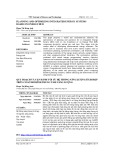
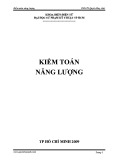
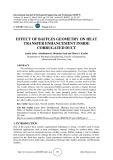
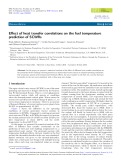
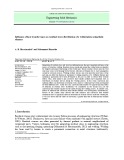








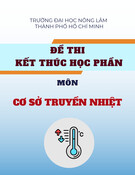

![Ngân hàng trắc nghiệm Kỹ thuật lạnh ứng dụng: Đề cương [chuẩn nhất]](https://cdn.tailieu.vn/images/document/thumbnail/2025/20251007/kimphuong1001/135x160/25391759827353.jpg)






